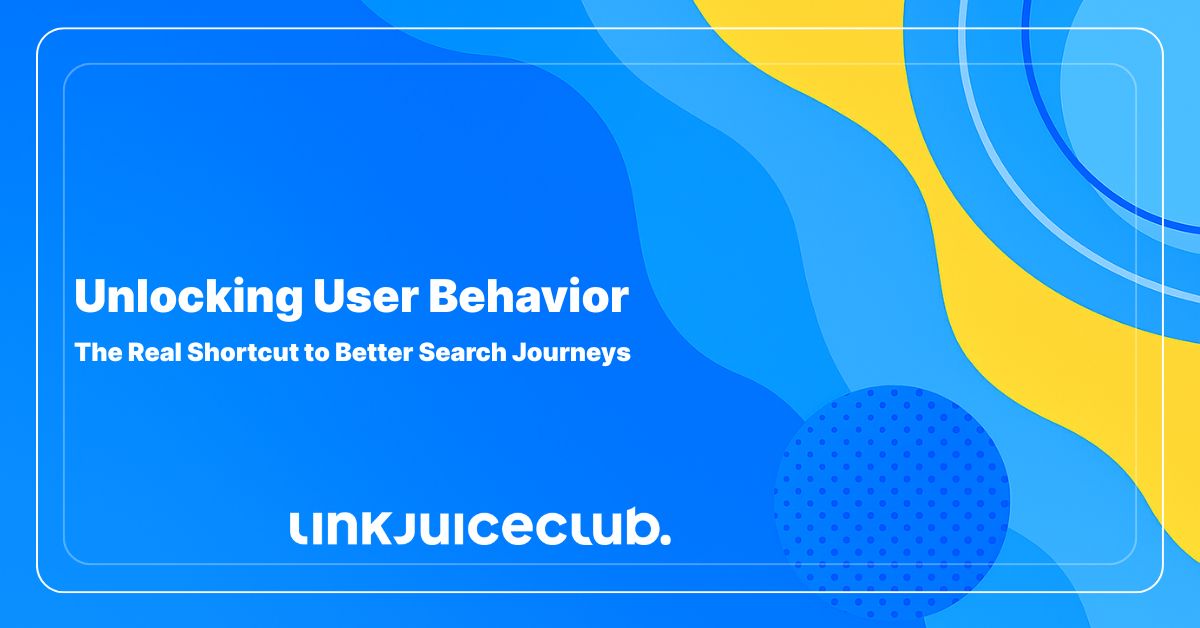
Unlocking User Behavior: The Real Shortcut to Better Search Journeys
Let’s cut to the chase: behavioral data is the cheat sheet you’ve been ignoring. It tells you what actually sparks a search, where people are carrying it out, and where they get stuck before hitting that golden conversion.
It’s the end of 2025, and SEO has already gone through more rebrands than a boy band reunion tour. We’ve had GEO, AEO, and now even LLM optimization is trying to sneak into job titles. Cute acronyms aside, here’s the thing: while the industry obsesses over machine-driven discovery, there’s one VIP we risk leaving out of the equation—the user.
Why Behavioral Data Deserves the Spotlight
Understanding behavioral data isn’t just another SEO trick. It’s how you figure out the “why” behind every search. What problem pushed someone to type (or speak) that query? Where are they searching from? And what kind of friction makes them bounce instead of buy? Nail those answers, and you’re not just optimizing—you’re actually helping.
And yes, thanks to those juicy Google trial leaks, we know user signals are more than whispers in the dark. While Google’s spokespeople never exactly confirmed it, Rand Fishkin and other industry veterans have pointed to patents and leaked documents suggesting that user behavior likely influences search rankings.

Here’s the kicker—search isn’t just about keywords anymore. With queries morphing into full-blown conversations inside LLMs, user-level data is fuzzier than ever. But guess what? Human behavior runs on patterns, and those patterns don’t change nearly as fast as algorithms do.
The Simple Rules That Guide Online Behavior
Human behavior follows a few steady principles that show up in every digital journey. People choose the path that requires the least effort, they prefer options that feel safe, and they gravitate toward outcomes that bring the greatest reward.
These instincts shape the way users interact with search results and websites. Search engines may change their systems regularly, yet human behavior remains steady. By focusing on the behavioral data that reveals these patterns, you create a stronger foundation for sustainable visibility and growth in organic search.
The Behavioral Data Playbook: How to Decode Search Journeys
Everyone talks about algorithms, but let’s be real: the secret weapon isn’t buried in Google’s code—it’s hidden in your users’ behavior. Behavioral data in SEO tells you what triggers a search, which rabbit holes people explore, and what invisible walls stop them from converting.
At Link Juice Club, we look at three key layers of behavioral gold: discovery channels, built-in mental shortcuts, and underlying user needs. Put together, they turn messy search journeys into predictable patterns you can actually optimize for.
1. Discovery Channels: Where the Journey Really Begins
Remember when search always started on Google? Yeah, those days are long gone. Today, people bounce between TikTok, Reddit, Instagram, and yes—LLMs—before they even consider your site.
That’s why behavioral data in SEO isn’t just about ranking for keywords—it’s about knowing where your audience hangs out and how they consume content. Discovery indicators tell you:
- 🎯 Which channels bring users in (beyond the obvious ones).
- 🧑🤝🧑 Who they are demographically.
- 🔥 What content formats capture attention.
- 🗣 What triggers make them engage.
Example? TikTok drives inspiration, but Millennials and Gen Z don’t want polished ads—they want authentic voices. Meanwhile, Reddit thrives as the go-to place for raw, unfiltered experiences. If you’re only measuring traffic from Google, you’re missing half the story.
Pro tip: map referral and source data from your analytics platform, and back it up with simple “Where did you first discover us?” surveys. Pair that with the rise of LLM-driven queries, and you’ll see why visibility isn’t about one keyword anymore—it’s about showing up across every intent a user might have.
2. Mental Shortcuts: How Brains Really Search
Here’s the thing: humans are lazy. Not in a bad way, but in an evolutionary, energy-saving way. We don’t have endless cognitive fuel, so when we search, we lean on heuristics and biases to speed up decisions.
Cognitive Biases: Built-in Glitches
Biases are systematic little quirks in how we perceive information. Take the list-position effect—we remember the first and last items on a list better than anything in the middle. That’s why your top product or core message should sit front and center.
Other heavy hitters include:
- 🧮 Anchoring bias → we judge everything against the first option shown.
- 🚫 Negativity bias → bad experiences stick harder than good ones.
- 🔎 Confirmation bias → we look for info that backs up what we already believe.
Heuristics: Shortcuts That Work (Mostly)
Heuristics are mental shortcuts that guide people toward quick decisions. The familiarity heuristic means people pick brands they know—it feels safe. Loss aversion explains why users often choose the safer path, even when that decision reduces the chance to gain immediate benefits.
There are approximately 100 of these biases and heuristics, but the key takeaway is simple: if you understand which ones are shaping your audience’s choices, you can design smoother search paths.
3. Underlying Needs: The Real Driver Behind Every Click
Biases and heuristics explain quick choices, but underlying needs are the foundation of the entire search journey. These needs don’t just surface in queries—they’re woven through channels, engagement patterns, and conversion gaps.
Say your data shows heavy loss aversion queries (“Is this brand legit?”, “Returns policy?”) plus low conversion rates. If those same users are also watching tons of UGC reviews, the takeaway is crystal clear: people don’t trust your brand yet.
This is where trust becomes non-negotiable. Too many brands assume credibility is a given—but users see it as a decision-maker. Meeting this underlying need often requires going beyond SEO: improving product transparency, leaning on authentic testimonials, or building reassurance into the purchase flow.
When you align biases and heuristics with these deeper needs, you get insights that power not just SEO, but retention and loyalty too. And that’s the ultimate ROI of behavioral data in SEO: it doesn’t just get you found, it keeps you chosen.
Algorithms shift, acronyms multiply, but people? People are far more predictable. That’s why behavioral data in SEO should be your north star. Map the channels, decode the shortcuts, and uncover the needs driving every query. Do that, and you’re not just chasing rankings—you’re mastering the messy middle.
Turning Behavioral Data Into Real Search Wins
SEO has always been obsessed with numbers. Sessions, bounce rates, CTRs—if it fits in a spreadsheet, we’ll track it. But here’s the twist: the real magic happens when you blend those hard numbers with human context. That’s where behavioral data in SEO takes your strategy from “good” to “game-changing.”
Numbers vs. Narratives: Getting the Full Picture
Quantitative data is your scoreboard. It tells you what happened: time on page, drop-off rates, cart abandons. Tools like Google Search Console and Google Merchant Center highlight when CTRs tank or when your localization isn’t working as planned. Google Analytics (or whatever analytics flavor your brand uses) digs deeper, letting you track custom events like sign-up actions.

Then you’ve got eye-tracking and heatmaps gadgets like Microsoft Clarity. These show you where eyeballs land, what people scroll past, and what gets ignored entirely. It’s visual proof of what works and what’s wasted space.
But numbers alone are only half the story. Qualitative data fills in the “why.” Surveys, customer logs, or scrapes from Reddit and Trustpilot reveal frustrations in your users’ own words. Live user testing even if it’s not scalable can instantly expose flaws that weeks of number-crunching might miss. Pairing both types of data means you’re not guessing at intent; you’re seeing it in full color.
AI: The New Wingman for Behavioral Insights
Let’s be honest—the industry spent the last year either glorifying AI as our replacement or mocking its every blunder. Reality? It’s neither a villain nor miracle—it’s a power tool.
- 🤖 Stitch together massive datasets and pull out actionable insights in seconds.
- 🔄 Generate synthetic data sets when your sample is too small.
- 📈 Forecast behaviors before they happen, so you can be proactive instead of reactive.
In other words, AI supercharges behavioral data in SEO. Instead of drowning in raw numbers, you get actual patterns you can work with.
Putting Behavioral Data to Work
So, how do you turn all this data into action instead of another 80-slide report no one reads? Easy: build dynamic dashboards that track discovery channels, cognitive shortcuts, and underlying needs—the three pillars we’ve already broken down.
Here’s the process:
- 🗂 Spot trends → use your dashboards to highlight new behavior patterns.
- 🎯 Prioritize → rank actions by business impact vs. implementation effort.
- 🔄 Apply broadly → don’t silo fixes. Behavioral insights often improve multiple sections of your site, or even your whole marketing strategy.
- 🤝 Collaborate → schedule regular syncs with UX and product. SEO might be your lane, but the user journey doesn’t care about org charts.
Because here’s the truth: when you treat traffic drops or low CTRs as isolated “SEO problems,” you’re just patching leaks. When you leverage behavioral data in SEO, you’re fixing the entire pipeline—from search to conversion to retention.
The Bigger Picture
Algorithms will always shift. Features will always change. But people? They’re wonderfully predictable in the ways that matter. That’s why behavioral data in SEO is the compass that keeps your strategy pointed in the right direction. Master the numbers, decode the narratives, and work across teams.





